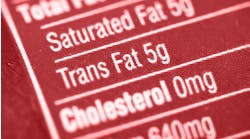When it comes to dietary health, cardiac concerns are right at the heart of things.
The heart is arguably the organ most directly affected by its owner’s long-term eating habits. When it comes to cardiac health, the list of dietary heroes is not only long, but ranges from the familiar (fiber) to the obscure (oleic acids). And of course, cardiac health is a vital concern, with heart disease being the leading cause of death in America.
As a result, heart health is well established as a dietary benefit. Between 2014 and 2018, the annual proportion of new food and beverage launches that make a heart-health claim ranged from 17.1 percent to 20.2 percent, according to Innova Market Insights.
Food and beverage marketers can avail themselves of Heart-Check, a certification program run by the American Heart Assn. to distinguish foods that are especially healthy from a cardiac perspective; almost 100 have done so, for more than a thousand SKUs.
When it comes to product categories making heart-healthy claims, the leader is cereal, at 8.0 percent of hot cereals and 6.9 percent of cold ones, according to Innova. Other leading categories include oils (5.7 percent), snack nuts and seeds (4.9 percent) and tea (4.6 percent).
As for items carrying the Heart-Check symbol, among all the processors and agricultural associations that have received this certification, the most common category is snack nuts at 28, followed by meat and seafood at 27 and produce (including potatoes) at 25. (The number of products per processor ranges from one SKU to dozens.)
“The Heart-Check program was started in 1995 and [was] based on the new health claim for coronary heart disease established by the Nutrition Labeling and Education Act around that time,” says Jayme Sandberg, senior communications manager for the American Heart Assn. “The Heart-Check program has seen steady growth through the years as it has evolved to stay in step with the American Heart Assn.’s nutrition guidelines and federal packaging health claim requirements.”
Holistic health
However, the situation regarding cardiac health and food is far from straightforward.
There are six ingredients recognized by the FDA as heart-healthy and adopted by the American Heart Assn. for the Heart-Check program: vitamin A, vitamin C, iron, calcium, protein and dietary fiber. (Heart-Check also places limits on fat, cholesterol and sodium.) All of these, however, have health benefits that extend beyond the heart. This gives marketers of foods rich in those nutrients a chance to make more comprehensive health claims.
Melissa Abbott, vice president of culinary insights for the Hartman Group, says they would be wise to do so, because consumers are moving away from taking health claims in isolation. “We’re seeing the body as a system today,” Abbott says. “It’s not just like, ‘I’m only going to treat my heart health now.’”
Older consumers, she says, may be more willing to focus directly on the heart as a health goal, but the wider spectrum of consumers tend to take the broader view.
“It’s less about the callouts on the food itself, and more about the inherent ingredients in the food,” she says. “The ingredients themselves have to speak to heart health in a way that’s less overt. It’s all holistic now. You can’t just treat heart health without thinking about the microbiome and gut health.”
That may account for why, although a robust proportion of new products identify themselves as heart-healthy, the year-to-year growth of such claims in the U.S. is anemic: a compound annual growth rate of 0.9 percent, according to Innova. (The global rate is 4.3 percent.)
“The subdued growth in this area suggests that there may be a lack of a catalyst to drive growth on the ingredient front,” says Tom Vierhile, Innova’s vice president for strategic insights-North America. “It could also suggest that companies are gun-shy about making ‘heart health’-related product claims.”
That shyness probably got a boost when the FDA decided, for the only time in its history, to consider pulling soy protein off the list of ingredients that entitle food marketers to make an “authorized health claim.”
Soy protein was added to the authorized list, the highest FDA standard, in 1999, in a claim that it can reduce the risk of heart disease by lowering blood cholesterol as part of a diet low in cholesterol and saturated fat. That sparked a surge in sales of soy milk, soybean oil and other soy-based products.
But in October 2017, the agency announced that it was considering downgrading soy protein to a “qualified health claim,” which would require a disclaimer on labeling that its effect on preventing cardiac disease was not conclusively proven. The matter is still under review.
Not coy about soy
Nonetheless, soy advocates are aggressively pursuing the connection between soy protein and heart health. The Soy Nutrition Institute recently released a meta-analysis of 46 nutritional studies that evaluated subjects’ reaction to being fed soy protein, concluding that it led to a significant lowering of low-density lipid (LDL) cholesterol.
“There are two ways in which soy foods can lower cholesterol,” says Mark Messina, executive director of the Soy Nutrition Institute. “One is the direct or intrinsic effect of the protein, which results in about a 3-4 percent reduction in LDL-cholesterol. The other is a displacement or replacement (extrinsic) effect, which results from the change in the fatty acid content of the diet when soy foods replace foods high in saturated fat. The combined approach can be expected to lower LDL-cholesterol 7-8 percent.”
The FDA has made another significant move relating to soy products, deciding late last year that edible oils with high-oleic acid could carry a qualified health claim about cardiac benefits. This opens the possibility for processors to make heart-health claims for products that use soybean oil varieties that are high in oleic acid, says Frank Flider, a consultant for Qualisoy, a unit of the United Soybean Board.
“CPG and private label brands with existing products that meet FDA requirements can now add a heart health claim to their labels, with inclusions on the proper disclaimers, which could help drive sales,” Flider says. “The announcement may also motivate brands to reformulate products, such as salad dressings or bottled vegetable oils, using oils high in oleic acid, such as high oleic soybean oil.”
Corteva Agriscience, the company recently spun off from DowDuPont, markets Plenish high-oleic soybean oil. In addition to its cardiac benefits, the oil “offers functional and nutritionsal benefits for both foodservice and food processing, providing extended shelf life and longer fry life,” says a spokesman for the company.
Corteva also makes Omega-9 Canola Oil. Unlike omega-3 and -6 fatty acids, omega-9s are monounsaturated fatty acids. Also unlike the other omega oils, omega-9 is nonessential – the body naturally produces it – but it’s a far better fatty acid to consume than saturated fats.
Going nuts
The FDA extends the concept of heart health beyond ingredients like soy or omega-3 fatty acids to entire foods. For instance, it authorized a qualified heart-health claim for tree nuts in 2003.
That serves as the main basis for the heart-healthy claims on packages of products of snack-mix processor Cibo Vita; it’s part of the title of Heart Healthy Mix. Other products include Omega-3 Deluxe Mix, Cranberry Health Mix, Omega-3 Nut Mix and Hazelnuts. The basis for those claims is a combination of the FDA’s tree-nut authorization and, in the case of products containing walnuts, the presence of omega-3 fatty acids.
“We mainly use the Heart Healthy Logo on trail mixes containing walnuts as a source of omega-3,” says Joyce Maia, Cibo Vita’s director of sales support services. “Such products are performing well on the market and we believe it has a wide appeal for the whole family, not for a specific consumer group.”
Blueberry Muffins from Flax4Life make a heart-health claim, but it’s equally billed with other claims.
Heart health is also a claim on some of the products of Flax4Life, which markets a line of flax-rich muffins and other baked goods, as well as granola, based on the omega-3 acid content of flax. However, the heart-health claims on Flax4Life packaging are in very small type, and appear on some products alongside claims for things like digestion and prostate health.
Marketing director Sarah Bishop believes that with Flax4Life products, the cardiac health benefit of omega-3 acids is second in consumer appeal to the digestive and other benefits of fiber. “The healthy heart benefits probably attract consumers above the age of 35, with most being over 45,” she says.
While cardiac health is top of mind for many consumers, the benefits of specific nutrients often go beyond the heart. Marketers must do their best to determine the priority their consumers place on cardiac health and adjust the focus of their health claims accordingly.


